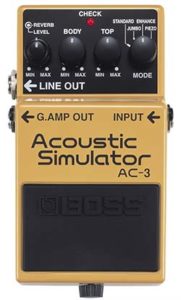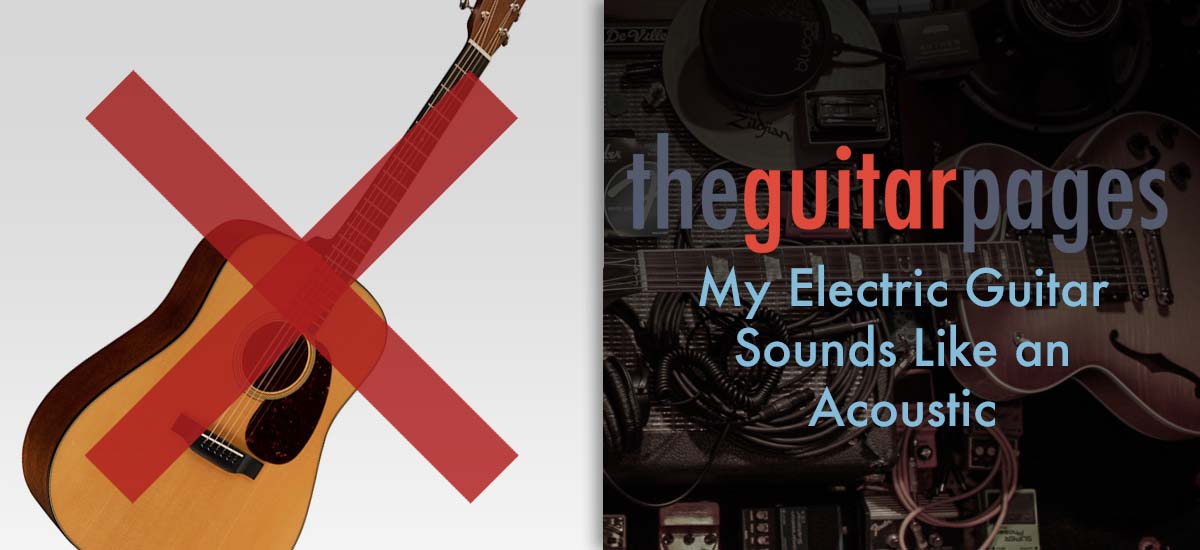You plug in and expect to hear a raging wall of rock and roll but instead a wimpy clean tone dribbles from your electric guitar. It sounds thin and feeble almost like an acoustic. The culprit could be anywhere from the guitar to the amp. In this article we’re going to look at how to diagnose a problem like this and how to fix your acoustic sounding electric guitar.
The Problem
The electric guitar sounds like an acoustic.
The expected result is a strong tone, that even with clean amp settings has a full sound, and when overdriven has an even, strong distortion.
To be clear, we’re not talking about a clean electric guitar tone. With a clean amp setting, and no effects, your guitar tone should be quite clear with no real distortion. Some young players take this to mean that their guitar sounds like an acoustic. If no distortion happening when distortion was happening before, you’ll want to take a look at either your amp settings or effects pedals to make sure your overdrive or distortion wasn’t turned off.
This specific problem deals with an electric guitar outputting a weak tone resulting in an acoustic like sound.
Recommended article: The Best Clip On Tuners for Guitar
Diagnosing the Issue

like a… oh dang it.
First step is to turn off your acoustic simulator. Just kidding. I’m guessing you’ve already ruled this one out.
The real first step is to pinpoint where the issue is coming from. If the problem isn’t in the amplifier, then it is in the signal chain preceding the amp. We’re going to start with the amp and then move up the chain to the guitar.
For newer players, these are important skills to learn. It’s also important to know that while purchasing good quality gear helps you be successful as a guitar player, all instruments, amps, etc. regardless of price need to be repaired at some point. I have done repair on just as many high end Gibsons and Fenders as I have on entry level guitars.
The more repair skills you have in your tool belt, the more money you’ll save over your life as a guitar player.
“My brand new guitar is sounding like an acoustic.” Well in that case take it back to the shop you bought it at and have them fix it. Rarely will a shop send the guitar back to the manufacturer for repair because shipping costs are so expensive. Most likely they will be happy to do the repair right there in the shop and hand you back your guitar in working order.
If the problem is in the signal chain before the amp, we’re most likely dealing with a component that is severely limiting the voltage generated by the pickups to reach amp. This could happen from a number of places, so let’s get started.
Simplify the Chain
First and foremost, we need to simplify the signal chain as much as possible. This means removing anything in between the guitar and the amp.
Unplug from any effects pedals, tuners, etc. and make sure the guitar is plugged directly into the amp.
Start with the Amp
An electric guitar may have an acoustic sound to it if the volume, gain, or tone are turned down close to zero. Put your amp settings so they’re all around the 50% mark. Does it still sound like an acoustic?
If you’re using a modeling amplifier, like the Fender Mustang LT-25, make sure that the settings are not configured for an acoustic tone. Set the amp to have no effects, and a higher gain model. If it gets better, then it was an amp configuration. If you’re still having the issue then keep reading.
Check the Guitar Controls
Make sure all of the controls, both volume and tone are turned all the way up which is all the way to the right. Strum the guitar and sweep the pots back and forth listening for any change in the sound. Use the pickup selector and do the same, selecting all possible positions.
What is a pot? A pot, short for potentiometer, is a component that offers variable resistance. Pots used on guitars come in all flavors and values, the most common being 250k and 500k. Those values refer to resistance in Ohms. The term pots is used to refer to one or all of the volume and tone controls on a guitar or amp
If the sound gets better when sweeping the pots, then you either have a bad or dirty pot. It’s possible that it can just be cleaned out, or it may need to be replaced.
Cleaning Pots
Recommended Article: Setup Like A Pro: How to Clean Guitar Electronics
If there is a scratchy noise coming from the amp while sweeping the pots on your guitar, it means that the pots are most likely dirty and can simply be cleaned. Dust, dirt, and grime get into the pots over time, adhering to the resistive element and the wiper.
This is the best contact cleaner I’ve found for cleaning guitar components, especially pots. Plus it’s cheap!
I find the best way to clean pots is to pull the guitar electronics and spray contact cleaner inside the opening of the pot. This gives you the most direct access and will clean out the pot best. On my Strat, it’s pretty easy. Just pull the pickguard and you’re good to go.

On other guitars, such as my Gibson ES-137 semi-hollowbody that doesn’t have an access hatch to the back of the pots, this can be a whole lot trickier. Thankfully StewMac thought up a solution to that and have a tool that just slips over the pot shaft which you then shoot contact cleaner into. The tool guides the cleaner down the shaft and into the pot. I find that this doesn’t work as well as pulling the electronics, but it saves a ton of time in the right situation.
Active Pickups
Another culprit I’ve seen is a dead battery in an active pickup configuration. I’ve worked with many beginner guitarists who pick up a guitar with active pickups and have no clue that there is even a battery in it. No judgement, they can be pesky things, those batteries.
How do you know if there are active pickups in your guitar? Most of the time, there will be a pretty clear battery compartment that is usually on the back of the guitar. Sometimes, especially if active pickups were installed later, the battery is tucked away in the control cavity.
Make sure that you’re unplugging your guitar after you’re done playing it. Otherwise, the pickups can still be drawing a small amount of voltage from the battery, significantly shortening its life.
Swap in a fresh 9v battery and see if this fixes the problem.
Wiggle Jack
Sometimes output jacks on guitars can oxidize or corrode over time, leaving a thin film restricting contact between the jack and the instrument cable. Sloppy tolerances often found in cheaper guitars can also cause this issue.
Strum a chord then move the cable in and out of the jack. The sound should cut in and out cleanly without a slow loss of signal, or without diminishing the overall tone of the guitar.
You should expect a small amount of popping when pulling the instrument cable from the output jack. Just make sure to have the amp at a reasonable level, or this will be incredibly loud and annoying.
Instrument Cable
Oftentimes the instrument cable can be an afterthought. Unfortunately, this is also one of the most common points of failure. The cable is jerked around constantly, moving and flexing quickly.
The solder joints where the cable connects to the jacks generally receive some of this movement causing the connection to slowly break. A good quality cable will make a big difference here.
If you have another cable swap it in and see if anything changes. If so, you’ve got a bad cable on your hands.
Here’s a tip. Learn how to repair cables. Small electronics skills and tools will allow you to fix your gear which saves you both a trip to the guitar shop, and quite a bit of money over the life of all your equipment.
Don’t expect all of your gear to be perfect all of the time. Even if I buy a nice guitar cable, I know that someday the wear and tear of using it day in and day out will take its toll and someday it’ll stop working. Instead of complaining about it, or buying a new one, I know how to fix cables and so I can be back up and running in no time.
Guitar Wiring Problems
If none of these steps help, you may have something wrong with the wiring inside the guitar. Wires go from the pickups to the pots and pickup selector and then run to the output jack. There is also a simple grounding setup which completes the circuit and keeps noise and hum to a minimum.
Sometimes wiring goes bad, pots go bad, switches go bad, grounding goes bad, or sometimes the wiring had issues to begin with. Cold solder joints aren’t uncommon in mass produced guitars, and poorly dressed leads that allow wires to either cross, or ground out have shown up in many guitars that are produced these days.
If you’re feeling adventurous, I’d encourage you to dig into the electronics of the guitar. Or take it to a local guitar tech and ask if you can watch while they diagnose the problem. You can learn a ton from watching someone who has run into all of these problems hundreds of times.
Pickups
Sometimes pickups can also be the culprits, and oftentimes they are the last component to be checked as they are not particularly inexpensive to replace. Pickup wires are very fine and can easily be damaged.
A competent guitar repair tech will be able to diagnose pickup issues and determine if they can be fixed, or if they need to be replaced.
Amp
If everything above checks out, the issue is most likely in the amp. Again, at this point the best move is to take your guitar, cable, and amp into your local guitar shop and have them confirm something is wrong. They’ll be able to point you toward repair, or replacing the necessary pieces.
Sometimes amps (especially digital modeling amps) are so complicated that repair isn’t really an option. Amps are cheap enough too that a new one is often the best option. Thankfully this is rarely the case.
The Pedal Board
For this exercise, you’ve removed the pedal board and any effects from the equation. However, if you plug back in to your board and the problem comes back it’s safe to say it’s coming from something on the board. A bad pedal could make your electric guitar sound like an acoustic guitar. Which is what we’re trying to avoid.
Make sure that all pedals are getting power, either through a power supply or fresh batteries. In the same way that active pickups can start to fade on a low battery, pedals will also lose their effectiveness with a weak battery. While you’re at it, just get a power supply, batteries are a pain to swap out and really start racking up the additional costs.
Once you know all pedals are getting proper power start removing units one by one until the problem goes away. Now add the other effects back in, and you’ve now just found your culprit.
Conclusion
This is one of those issues that require some troubleshooting and possibly a bit of light repair work. Don’t be discouraged. Enjoy the process of finding the issue and solving it. I promise, this won’t be the last time in your guitar playing career that you’ll have to track an issue down.
